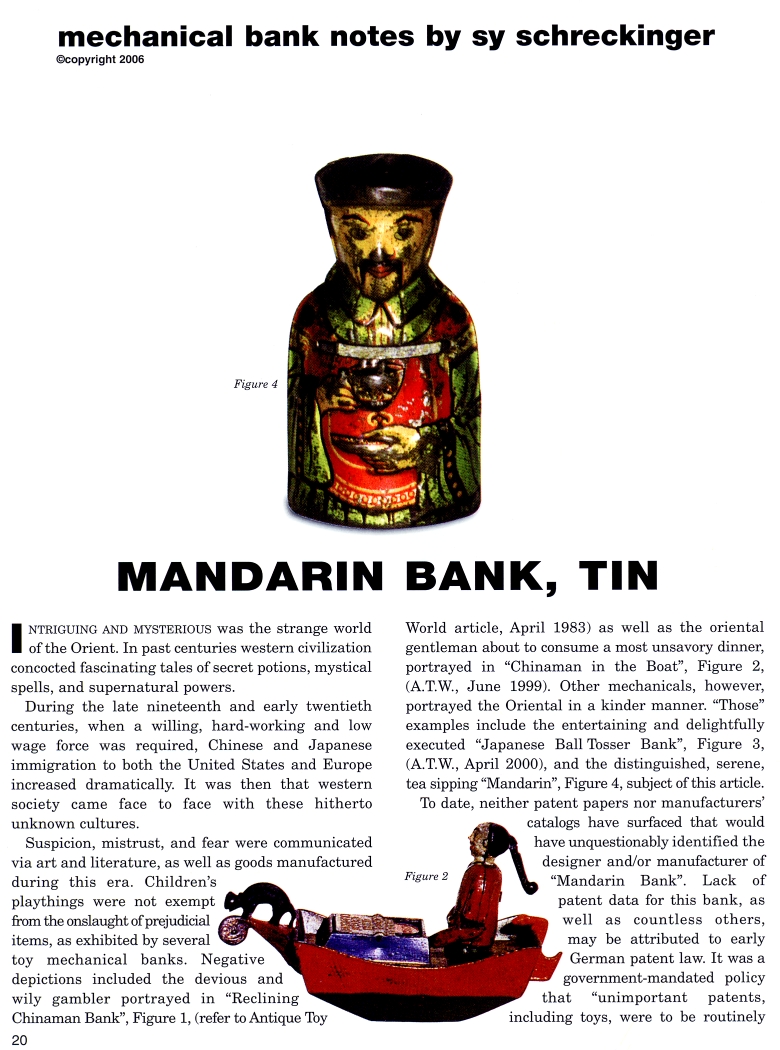|
Mandarin Bank, Tin
by Sy Schreckinger – ANTIQUE TOY WORLD Magazine – March, 2006
Intriguing and mysterious was the strange world
of the Orient. In past centuries western civilization concocted
fascinating tales of secret potions, mystical spells, and supernatural
powers.
During the late nineteenth and early twentieth centuries, when a
willing, hard-working and low wage force was required, Chinese and
Japanese immigration to both the United States and Europe increased
dramatically. It was then that western society came face to face with
these hitherto unknown cultures.
Suspicion, mistrust, and fear were communicated via art and
literature, as well as goods during this era. Children's playthings were
not exempt from the onslaught of prejudicial items, as exhibited by
several toy mechanical banks. Negative depictions included the devious and
wily gambler portrayed in "Reclining Chinaman Bank", Figure 1, (refer to
Antique Toy World article,
April 1983) as well as the oriental gentleman
about to consume a most unsavory dinner,
portrayed in "Chinaman in the Boat", Figure 2, (A.T.W.,
June 1999). Other
mechanicals, however, portrayed the Oriental in a kinder manner. "Those"
examples include the entertaining and delightfully executed "Japanese Ball Tosser Bank", Figure 3, (A.T.W.,
April 2000), and the distinguished,
serene, tea sipping "Mandarin", Figure 4, subject of this article.
To date, neither patent papers nor manufacturers' catalogs have
surfaced that would have unquestionably identified the designer and/or
manufacturer of "Mandarin Bank". Lack of patent data for this bank, as
well as countless others, may be attributed to early German patent law. It
was a government-mandated policy that "unimportant patents, including
toys, were to be routinely discarded after fifteen years of issuance".
This practice has proven to be a hindrance to today's mechanical bank and
toy historians.
The recent discovery of a toy wholesaler's catalog (Figure 5), circa
August 1908, produced by the Maienthau and Wolff Company of Nurnberg,
Germany, does offer significant information. In it is pictured the
"Mandarin Bank" and the following descriptive: "5785/1, 9.5 cm tall, cost
.14 Part Mark, shipped 12 to a box". Such information has provided
collectors and historians with this mechanical's approximate date of
manufacture, country of origin, and general pricing.
However, there is puzzlement involving the firm of Maienthau and
Wolff itself. The question remains unanswered as to whether the company
was a manufacturer, or a jobber of tinplate items, or perhaps involved in
both. This lack of conclusive data has led many collectors to speculate
that "Mandarin Bank" was produced by yet another company of that region.
The bank's fine lithography and intricate tinplate construction is
suggestive of Saalheimer and Strauss Tin Works, one of the foremost
producers of tinplate mechanical banks of the era. "Mandarin Bank" is
constructed entirely of delicate and colorfully lithographed tinplate.
Operation is initiated by the insertion of a coin through the slot located
in the back of the bank. As the coin descends, the eyes tilt upward and
its queue wiggles. Deposits are removed, via a can opener, by forcefully
cutting out the sealed bottom of the bank (Figure 6). Unfortunately, this
was the only method of coin removal designed by its manufacturer.
"Mandarin Bank" is extremely rare, with less than a handful known to
exist. Its alleged intentional destructive method of coin purging,
delicate mechanism, and flimsy construction easily explain its scarcity.
I am not aware of the existence of reproduced examples of this
mechanical. However, in view of its fragile nature there is the
possibility of restored and/or replaced portions. As with any valued and
antique, limited professional conservation considered acceptable.
"Mandarin Bank" is quite miniscule in size: Height: 3-3/4 inches,
Width: 2 inches. Nevertheless, it is considered to be an extremely
desirable and attractive addition to a mechanical bank collection.
Acknowledgement: The fine, all original example "Mandarin Bank",
Figure 4, is from the collection of Bob Weiss.
|

